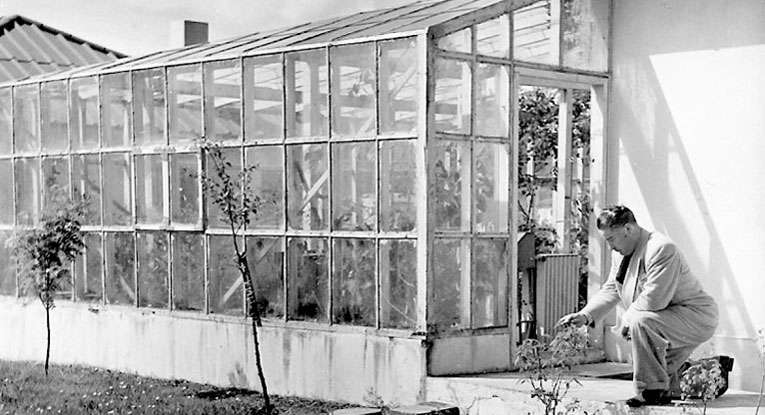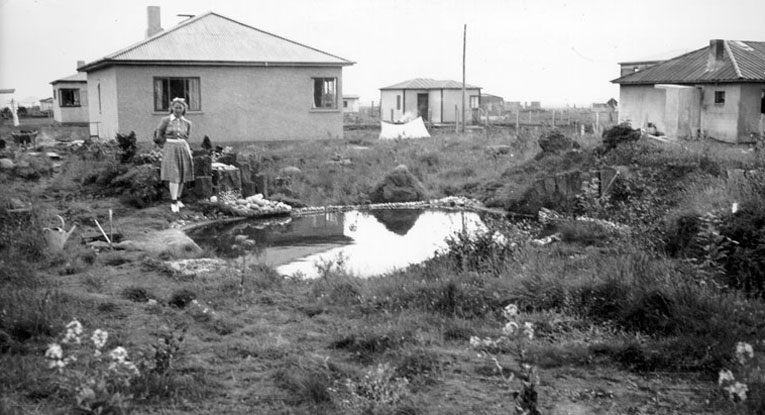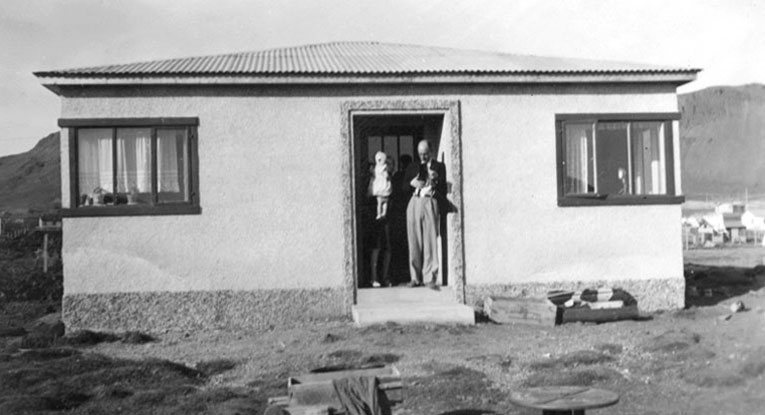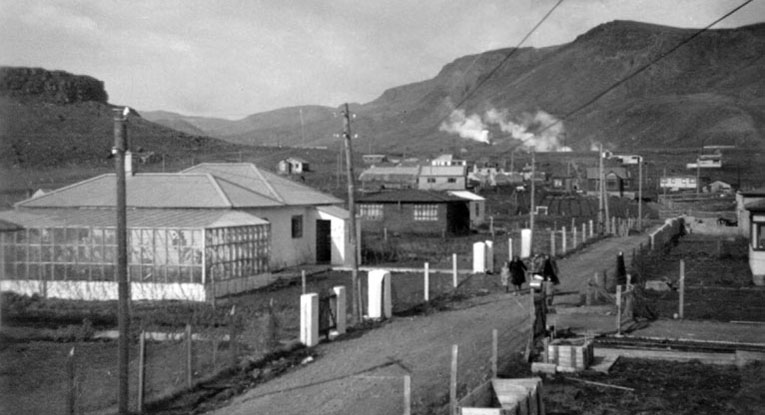The Artists’ Colony in Hveragerði
The poets who moved to Hveragerði in 1940, the year Iceland was occupied by the British army, and the following years, did so hoping to find better conditions than they lived in during the depression before WWII. They heard that heating was cheap and that cooking even took place in the hot springs themselves. There was a great shortage of housing in Reykjavík during this time and families were forced to live very close together.
First to move were Jóhannes úr Kötlum and family in October 1940 and Kristmann Guðmundsson, in February 1941. Both families had lost their lodgings in Reykjavík.
Around the same time, the painter Kristinn Pétursson moved to Hveragerði. His hope was that the mud springs in Hveragerði would benefit his health. The sculptor Ríkarður Jónsson built a summerhouse in Poet Lane in the same year as Kristmann and Jóhannes.
There was something seductive about living in a small peaceful village known for growing flowers and vegetables. Rev. Helgi Sveinsson and family moved to the same street as the poets the following year and a trio of poets that loved writing verse on the small town daily life was born. Some of the poems became famous, and collaboration between the poets and the gardeners produced annual gardening/artist dances. The trio wrote the first poem on Hveragerði, with each verse concluding in the words: “Hveragerði is the best place in the world”.
Conditions then and now
Conditions at the beginning of WWII were quite dissimilar from what they are today. Transportation and daily life were completely different then.
People travelled by coastal ships and buses. Air transport was almost unheard of. The roads were all made of gravel and some of them were only intended for horses and carriages. The road up to Hellisheiði was so winding that in some places the buses had to reverse to make the turns.
This was the situation when Jóhannes úr Kötlum moved with his family to Hveragerði, assisted by well-known bus driver Ólafur Ketilsson, in October 1940.
Poet Lane in Hveragerði
In the spring of 1941, Jóhannes úr Kötlum and Kristmann Guðmundsson had houses constructed in the westernmost street of the village, which was still unnamed at that point.
The third poet, Rev. Helgi Sveinsson, moved into the street the following year and after that it was called Poet Lane.
It wasn’t until 1946 that the streets in this new part of town were named and Poet Lane became “Frumskógar” (Jungle). By that time, poets Gunnar Benediktsson and Valdís Halldórsdóttir had joined the group and Gunnar had become town council chairman. According to Gunnar, this wasn’t a “proper street for years, apart from the houses being mostly parallel through the rough, tussocky ground”.
The artists worked together. They had wells drilled in the street for hot water, installed pipes to convey it to their houses and placed containers onto the pipes for cooking.
Garðshorn on Poet Lane – now Frumskógar 9
 Kristmann Guðmundsson lost his lodgings in Reykjavík in early 1941 and moved to Hveragerði with his fifth wife, Guðrún Guðjónsdóttir. He built a house at Poet Lane, called it Garðshorn, and grew a rare flower garden. Kristmann had nine marriages and an equal number of divorces. He had six daughters, Randí, Vildís, Hrefna, Ninja, Ingilín and Kaðlín. Kristmann was an eager spokesman for Hveragerði becoming an independent municipality, along with Gunnar Benediktsson and others. He also took part in drilling the first well used for heating houses in Hveragerði. He moved to Reykjavík in 1960.
Kristmann Guðmundsson lost his lodgings in Reykjavík in early 1941 and moved to Hveragerði with his fifth wife, Guðrún Guðjónsdóttir. He built a house at Poet Lane, called it Garðshorn, and grew a rare flower garden. Kristmann had nine marriages and an equal number of divorces. He had six daughters, Randí, Vildís, Hrefna, Ninja, Ingilín and Kaðlín. Kristmann was an eager spokesman for Hveragerði becoming an independent municipality, along with Gunnar Benediktsson and others. He also took part in drilling the first well used for heating houses in Hveragerði. He moved to Reykjavík in 1960.
Ljósafell on Poet Lane – now Frumskógar 7
 Rev. Helgi Sveinsson served at Arnarbæli and lived there with his wife, Katrín M. Guðmundsdóttir, and their son Haukur. Their housing was in poor condition and the place was desolate and lonely. They moved to Hveragerði in 1942 and built the house Ljósafell at Poet Lane, where their daughter María Katrín was born. The families in Poet Lane enjoyed a close, good relationship, and Katrín and Jóhannes’ wife Hróðný became lifelong friends. Helgi and Jóhannes wrote all the odes to Hveragerði together, the first one being co-written by Kristmann. Rev. Helgi died in an accident in Copenhagen in 1964.
Rev. Helgi Sveinsson served at Arnarbæli and lived there with his wife, Katrín M. Guðmundsdóttir, and their son Haukur. Their housing was in poor condition and the place was desolate and lonely. They moved to Hveragerði in 1942 and built the house Ljósafell at Poet Lane, where their daughter María Katrín was born. The families in Poet Lane enjoyed a close, good relationship, and Katrín and Jóhannes’ wife Hróðný became lifelong friends. Helgi and Jóhannes wrote all the odes to Hveragerði together, the first one being co-written by Kristmann. Rev. Helgi died in an accident in Copenhagen in 1964.
Vin on Poet Lane – now Frumskógar 5
 Gunnar Benediktsson and Valdís Halldórsdóttir were teachers living in Eyrarbakki. Valdís went on maternity leave and Gunnar began working as an interpreter with the British army in Kaldaðarnes. He later worked for the Socialist Party in Reykjavík and frequently needed to travel there, so he spent much time on the road. They called upon Jóhannes úr Kötlum who lived in Hveragerði and he arranged lodgings for them in Friðstein’s House in Bláskógar in the fall of 1943. They later bought a house at Frumskógar in 1944. Their children are Heiðdís, born 1943, and Halldór, born 1950. They moved to Reykjavík in 1975.
Gunnar Benediktsson and Valdís Halldórsdóttir were teachers living in Eyrarbakki. Valdís went on maternity leave and Gunnar began working as an interpreter with the British army in Kaldaðarnes. He later worked for the Socialist Party in Reykjavík and frequently needed to travel there, so he spent much time on the road. They called upon Jóhannes úr Kötlum who lived in Hveragerði and he arranged lodgings for them in Friðstein’s House in Bláskógar in the fall of 1943. They later bought a house at Frumskógar in 1944. Their children are Heiðdís, born 1943, and Halldór, born 1950. They moved to Reykjavík in 1975.
Miðsel on Poet Lane – now Frumskógar 10
 Jóhannes úr Kötlum and his wife Hróðný Einarsdóttir lost their lodgings in Reykjavík in the fall of 1940. They then moved to Hveragerði with their children, Svanur 11 years and Inga Dóra 3 weeks old. At first they rented Friðstein’s House, a newly built summer cottage with no heating, but the following year they built their house, called Miðsel, in a new street on the western edge of the village, later Poet Lane. A house for Kristmann Guðmundsson rose across the street around the same time and the two families instantly became quite close. Jóhannes and Hróðný spent the year 1946-47 in Sweden with their daughter, but then built a house in Brattahlíð 9 in Hveragerði where their daughter Þóra was born in 1948. They moved to Reykjavik in 1959.
Jóhannes úr Kötlum and his wife Hróðný Einarsdóttir lost their lodgings in Reykjavík in the fall of 1940. They then moved to Hveragerði with their children, Svanur 11 years and Inga Dóra 3 weeks old. At first they rented Friðstein’s House, a newly built summer cottage with no heating, but the following year they built their house, called Miðsel, in a new street on the western edge of the village, later Poet Lane. A house for Kristmann Guðmundsson rose across the street around the same time and the two families instantly became quite close. Jóhannes and Hróðný spent the year 1946-47 in Sweden with their daughter, but then built a house in Brattahlíð 9 in Hveragerði where their daughter Þóra was born in 1948. They moved to Reykjavik in 1959.
Bræðraborg on Poet Lane – now Frumskógar 6
 Kristján frá Djúpalæk moved to Hveragerði in the spring of 1950 with his wife, Unnur Friðbjarnardóttir. She had at that time been bedridden for three years from tuberculosis and Kristján had back problems and planned to recover from back surgery there. News of the healing powers of hot spring clay and inexpensive housing enticed them to Hveragerði and closeness to the other poets was a big asset. Jóhannes úr Kötlum assisted them in finding a house. Their son Kristján was born in 1959. They lived at Bræðraborg in Poet Lane until 1961 when they moved to Akureyri.
Kristján frá Djúpalæk moved to Hveragerði in the spring of 1950 with his wife, Unnur Friðbjarnardóttir. She had at that time been bedridden for three years from tuberculosis and Kristján had back problems and planned to recover from back surgery there. News of the healing powers of hot spring clay and inexpensive housing enticed them to Hveragerði and closeness to the other poets was a big asset. Jóhannes úr Kötlum assisted them in finding a house. Their son Kristján was born in 1959. They lived at Bræðraborg in Poet Lane until 1961 when they moved to Akureyri.















